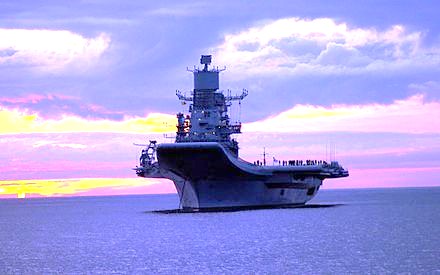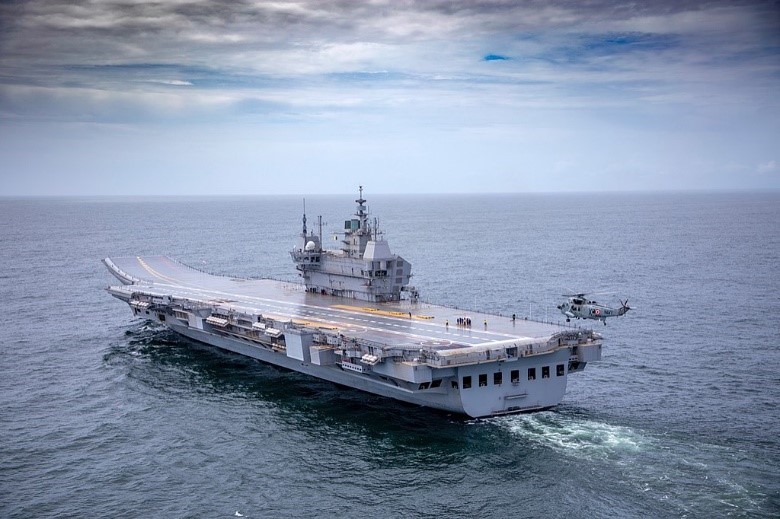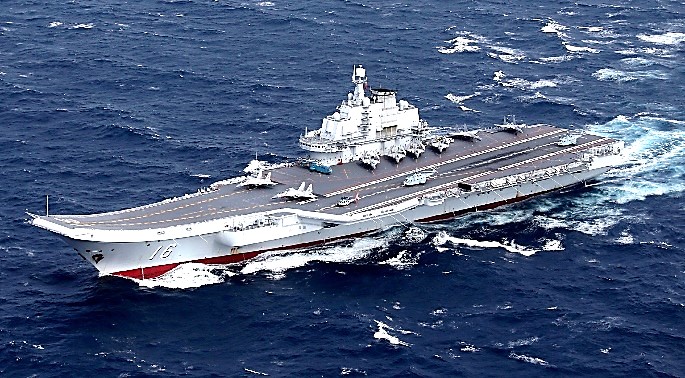
Indigenous Aircraft Carrier : Indian Navy’s Veritable Varuna
Mon, 16 Aug 2021 | Reading Time: 8 minutes

There have recently been some articles written by analysts and Navy veterans for and against the philosophy of the aircraft carrier (AC) as an instrument of war fighting and National power projection in the current global scenario, with reference to employment, cost and utility. This article will aim to identify India’s requirements of aircraft carrier based Naval fleet(s) against the backdrop of the regional conundrum, profile India’s ACs & the Indigenous Aircraft Carrier Program (IACP) and look at whether the capabilities of the Indigenous Aircraft Carrier (IAC) adequately supports India’s regional maritime security requirements.
Why Does India Need Aircraft Carrier Based Fleets (ACBF)?
In order to deduce the requirement (or non-requirement) of ACBF, it is essential to briefly examine India’s maritime security calculus. By geographical location, India shares waters with at least 10 Middle Eastern, South Asian and Southeast Asian littorals and has a substantial Exclusive Economic Zone (EEZ). The location also offers multi-avenued access to India’s proximal waters, from the Straits of Hormuz all around to the Straits of Malacca. These considerations outline India’s seaward accessibility and the consequent enhanced vulnerability to inimical actions by State or Non- State actors. India thus has to deliberately plan its Naval profile to be able to unambiguously project and deploy maritime might, in order to deter or thwart such inimical acts. Another important facet for consideration would be India’s strategic maritime interests. India sits at the crown of the Indian Ocean region (IOR) and therefore enjoys geostrategic proximity to a number of island territories with a history (or potential) of use as advanced strategic bases by other Nations. Add to this the Sea Lines of Communication (SLOCs) emanating from Africa, the Middle-East and Southeast Asia that are vital for India’s energy and trade requirements and one would arrive at the necessity to protect these links by physical action or threat of retaliation. Another important driver towards profiling India’s Naval might would be the geostrategic shift towards the Indo-Pacific continuum and India’s role as a net security provider / reckonable maritime power in the IOR/ across the waters bounded by the littorals of Southeast Asia and Oceania respectively. A quick scan of the regional maritime powers would indicate that our Western neighbour, though in possession of a numerically inferior Navy, could still pose a serious maritime threat to by virtue of physical proximity to the Indian mainland. A far more serious Naval threat would emanate from China’s People’s Liberation Army Navy (PLAN), which has the qualitative and quantitative wherewithal to threaten India’s maritime borders and SLOCs or challenge India’s status as a maritime power in the region.
Our growing regional stature would also increase expectations among the regional littorals of India’s capability to act as a ‘security balancer’ by presenting multi-domain deterrence to discourage any attempt at undermining regional stability. While there are arguments to develop the Andaman & Nicobar and the Lakshadweep Island Chains as unsinkable Naval carriers for ‘out-at sea’ operations, India’s perspective maritime role in the region would require persistence of Naval and Air power to undertake operations /present as a ‘threat in being’ anywhere in this battlespace. The above determinants across the regional battlespace underline the inevitable progress towards blue water capability and the undeniable requirement of multiple ACBFs!
India’s AC Profile
The requirement of a Navy with multi-dimensional capabilities became evident in the decades after independence. It was thus that India began her tryst with ACs, with the commissioning of INS Vikrant (previously HMS Hercules of UK) into the Indian Navy (IN) in March 1961. The AC was a 210 m long, 16,000 ton Light AC (an intermediate between full-fledged Fleet Carriers and smaller Escort Carriers) that was purchased in an incomplete state by India in 1957. The AC featured a ski-jump and carried upto 23 fixed/ rotary wing aircraft. The AC was orbatted to the newly created Eastern Fleet in 1971 and played an important role in enforcing Naval Blockade of then East Pakistan during the 1971 Indo-Pakistan War. The AC was decommissioned in January 1997, after serving for over 36 years.
India’s second AC was the 226.5 m long, 22,000 ton, 1959 vintage Light AC HMS Hermes, decommissioned by UK in 1984 and purchased by India before being commissioned as INS Viraat in May 1987. The AC featured a Short Take-Off But Arrested Recovery (STOBAR) design with a ski-jump. She carried upto 26 fixed/ rotary wing aircraft and served as flagship of the Western Fleet and principal warship of the IN till the induction of INS Vikramaditya in 2014. INS Viraat was decommissioned in March 2017, after serving for almost 30 years- the last British-built ship in service with the IN and the oldest AC in service in the world!
India’s third AC is the 284 m long INS Vikramaditya, a modified AC in the 42,000 to 45,000 ton class, commissioned by the Soviet Navy in 1987 (initially as Baku and later renamed Admiral Gorshkov), before being decommissioned by the Russian Navy in 1996. The AC was purchased by India in January 2004 at a cost of US $ 2.35 Billion, commissioned as INS Vikramaditya in November 2013 and formally inducted into the IN in June 2014. The AC carries upto 36 aircraft including 26 MiG 29K Multi-role Fighters and 10 Kamov Airborne Early Warning & Control (AEW&C)/ Anti-Submarine Warfare (ASW) Helicopters. This AC is presently the capital ship of the IN’s Western Fleet.
The IACP
As testimony to the overarching theme of ‘Atmanirbhar Bharat’ , the IACP is a much awaited and welcome step towards indigenous production of ACs, which puts India into an elite league of only a handful of Nations. The IACP received formal Government approval in January 2003.
IAC-1. The keystone of the IACP is the IAC-1, named INS Vikrant, in honour of the 50th anniversary of its predecessor’s participation in the 1971 conflict. The IAC-1 has been designed by the IN’s Directorate of Naval Design (DND) and is being constructed by Government owned Cochin Shipyard Limited (CSL). The process for building INS Vikrant commenced with initial design work in 1999 and the AC was launched in August 2013. Basin trials were completed in December 2020 and first sea trials lasted from 04 to 08 August 2021. The Government has pledged to dedicate the AC to the Nation on Independence Day 2022. The total cost incurred on the project at the time of the first sea trials is approximately US $ 2.3 Billion. The AC has upto 80 % indigenous content which includes anti-rust steel for the body developed by DRDO & Steel Authority of India Ltd and the Combat Management System (CMS) pioneered by Tata Power Strategic Engineering Division, with Russian collaboration. Technical consultancy for installation of certain assemblies has been provided by Italian firms while the aviation complex has been designed by Russia’s Nevskoye Design Bureau.
The AC is 262 m long/ 62 m wide with a loaded displacement of 45,000 tons. It features a STOBAR configuration with a ski-jump. The AC will carry upto 30 aircraft, including 24 to 25 MiG-29K Fighter Aircraft and 10 Kamov Ka-31 AEW&C/ Westland Sea King ASW Helicopters. The AC will also be capable of accommodating the Lockheed Martin MH-60 R Seahawk Multi-Role Helicopter and the Maritime Reconnaissance and Coastal Security ALH (MRCS), explained in an earlier article @ Chanakya Forum https://chanakyaforum.com/an-indian-helicopter-story/ . The IN is of the firm conviction that the AC will accord unprecedented capability in all facets of air operations.

INS Vikrant Undergoing Maiden Sea Trials: Source- Chanakya Forum
IAC-2. India’s second indigenous AC (IAC-2) (INS Vishal) and would be larger than its predecessor, with a displacement of upto 65,000 tons. The AC is also planned to be built at CSL and will incorporate new design features including a Catapult Assisted Take-Off But Arrested Recovery (CATOBAR) configuration Electromagnetic Aircraft Launch System (EMALS), presently used in ACs of the US Navy, which accords greater operational flexibility, as unlike the STOBAR configuration, no major design changes need to be incorporated in embarked fixed wing aircraft. The EMALS would allow for operation of larger aircraft as well as Unmanned Combat Aerial Vehicles (UCAVs). The flat-top AC will accommodate approximately 50 fixed and rotary wing aircraft. An initial amount of Rs. 30 Crores was allotted by the Defence Acquisition Council (DAC) for kickstarting the planning/construction process and DND commenced designing the AC in 2012. The AC is likely to enter service in the next decade either as the IN’s third AC or as replacement of INS Vikramaditya.
What is IN’s Standing As a Carrier Based Navy?
11 Nations worldwide today have ACs in service/under construction. Three Asian Nations including India have AC based Navies, while Japan and South Korea plan to join this elite club. Among these, only China is quantitatively ahead of India, with 2 ACs in service and 2 under construction, compared to India’s 1/1 respectively. This fact and the geostrategic conundrum alluded to above, merits comparison of India’s and China’s AC profile.
China presently operates the Type 001 Liaoning and Type 001A (002) Shandong ACs. The Liaoning is a Soviet Kuznetsov Class AC in the 43000 ton class (similar to own ACs in service/ under construction) with a ski-jump and STOBAR configuration. The AC was purchased from Ukraine in 1998, refurbished and commissioned into the PLAN in September 2012, giving it vintage akin to INS Vikramaditya. The Liaoning reportedly carries upto 36 aircraft including 24 J-15 4th Generation fighters, six ASW and four AEW&C helicopters and 2 rescue helicopters. This air operation capability is nearly identical to that of the INS Vikramaditya /INS Vikrant and would be inferior to that of INS Vishal. The STOBAR ski-jump configuration of the Liaoning poses significant performance limitations on the J-15 fighters which have a maximum take-off weight of 33000 kg, approximately 11000 kg more than the MiG 29K- a limitation that the fighter aircraft aboard the INS Vishal will not face, with the CATOBAR- EMALS configuration. The operational range of the INS Vikrant will be 15000 km, more than double that of the Liaoning! China’s indigenous Shandong AC, commissioned in December 2019, also with STOBAR configuration, would have a slight dimensional and operational edge over INS Vikrant, with the former having a length of 315 m, displacement of 65,000 tons, range of 25000 km and carrying capacity of 44 to 48 aircraft. However, most of these disadvantages would be overcome in INS Vishal. The Chinese Type 003 AC, under construction since February 2017, will be significantly larger with a displacement of 85,000 tons and CATOBAR- EMALS configuration similar to that planned for INS Vishal. This AC is likely to be launched in a similar timeframe as INS Vikrant. The Type 004 AC (construction reportedly commenced in December 2017) is likely to feature nuclear propulsion and be commissioned by the end of the decade. It is likely to carry J-15 and J-31 5th Generation fighter aircraft.


Liaoning / Shandong ACs: Source-nationalinterest.org/ Pinterest
Conclusion
While there would always be differences between drawing board and deployment in case of both India’s and China’s AC programs, it is evident that the necessity of a reverberant AC profile is the answer to retaining the capability to effect a ‘favourable sea situation’ should the requirement arise. China’s hegemonic and expansionist maritime approach has been repeatedly advertised in the developments in the South China Sea and forays into India’s maritime backyard in the IOR. This fact looms significantly when viewed in the unfavourable light of a possible collusive threat. Apropos, maintenance of Carrier Battle Groups to ensure safety of India’s maritime interests in the peninsula, with adequate redundancy to effect sea control over the significant battlespace in the IOR, would be an inescapable and an inexorable operational compulsion, that must not be lost sight of, now and into the foreseeable future.
********************************************************************************************************

Disclaimer
The opinions expressed in this article are the author’s own and do not reflect the views of Chanakya Forum. All information provided in this article including timeliness, completeness, accuracy, suitability or validity of information referenced therein, is the sole responsibility of the author. www.chanakyaforum.com does not assume any responsibility for the same.
Chanakya Forum is now on . Click here to join our channel (@ChanakyaForum) and stay updated with the latest headlines and articles.
Important
We work round the clock to bring you the finest articles and updates from around the world. There is a team that works tirelessly to ensure that you have a seamless reading experience. But all this costs money. Please support us so that we keep doing what we do best. Happy Reading
Support Us




















POST COMMENTS (7)
A New Ensign And A New Carrier: Indian Navy’s Red Letter Day - Chanakya Forum
Indian
Rohitash
Lepke Buchalter
LM Gantayet
Deepak Ranade
Rahul Sharma